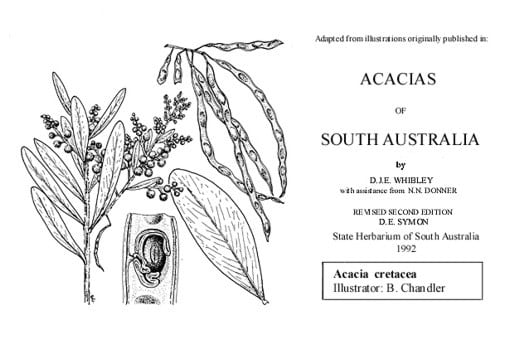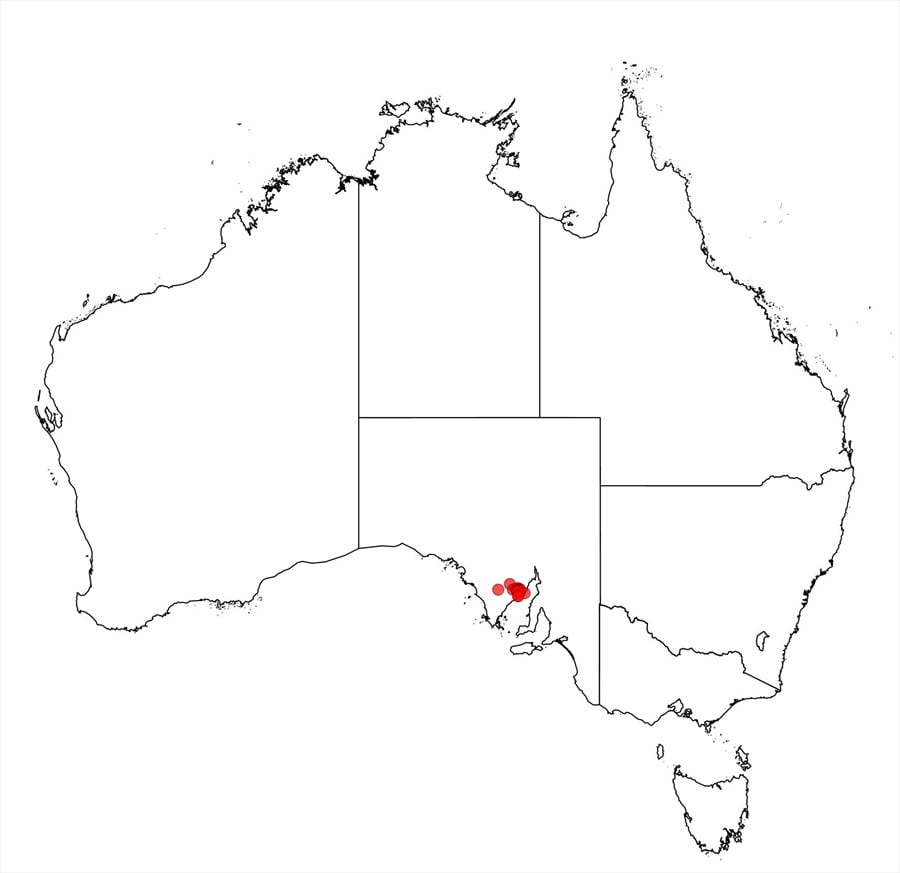Acacia cretacea Maslin & Whibley
WATTLE
Acacias of Australia
Family
Fabaceae
Distribution
Restricted to N of Cowell, north-eastern Eyre Peninsula, S.A.
Description
Spindly, straggly shrub or tree to c. 4 m high. Branchlets angled at extremities, pruinose, glabrous. Phyllodes rather crowded, on pronounced stem-projections, ascending to erect, narrowly oblanceolate to narrowly elliptic, straight, 7–10 cm long, 9–20 mm wide, occasionally wider (25–40 mm), obtuse, thin to coriaceous, grey-green, glaucous when young, glabrous, 1-nerved per face, finely penninerved; gland not prominent, 0–4 mm above pulvinus. Inflorescences racemose; raceme axes 2–4 cm long, pruinose, glabrous; peduncles 4–11 mm long, pruinose, glabrous; heads globular, 4–5 mm diam., densely 35–45-flowered, lemon yellow to golden; bracteoles glabrous. Flowers 5-merous; sepals 3/4-united. Pods linear, to 9 cm long, 5–6 mm wide, firmly chartaceous to thinly coriaceous, pruinose (young), glabrous. Seeds longitudinal, 5–7 mm long, slightly shiny, black; funicle 1/2 to wholly encircling seed in a single fold, reddish; aril clavate.
Habitat
Grows in deep red sand, in gently undulating country with low sand ridges, in low shrubland and mallee scrub.
Specimens
S.A.: near Cowell, M.Simmons 1722 (CANB, K, PERTH).
Notes
A rare species considered endangered, fide B.R.Maslin & D.J.E.Whibley, Nuytsia 6: 27 (1987).
Distinguished from other members of the 'A. microbotrya group' occurring on the Eyre Peninsula by its pruinose branchlets, inflorescences and pods; see B.R.Maslin & D.J.E.Whibley, Nuytsia 6: 27 (1987), for discussion. Related to A. toondulya. The more southerly distributed A. gillii has a similar habit to that of A. cretacea.
FOA Reference
Data derived from Flora of Australia Volumes 11A (2001), 11B (2001) and 12 (1998), products of ABRS, ©Commonwealth of Australia
Author
B.R.Maslin
Minor edits by B.R.Maslin, J.Reid & J.Rogers
This identification key and fact sheets are available as a mobile application:
URL: https://apps.lucidcentral.org/wattle/
© Copyright 2018. All rights reserved.













